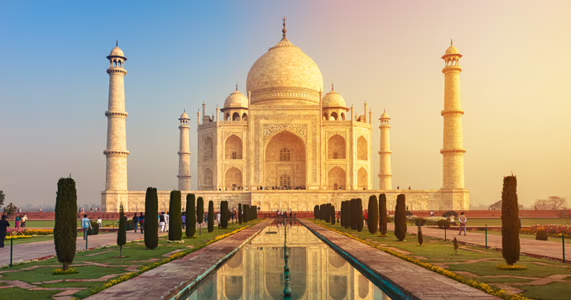
Rising gracefully on the banks of the Yamuna River in Agra, India, the Taj Mahal stands not merely as an architectural marvel, but as a powerful symbol of everlasting love. Clad in shimmering white marble and crowned with a bulbous dome that seems to kiss the sky, this UNESCO World Heritage Site is one of the most photographed, admired, and visited monuments in the world. Yet, to truly appreciate the Taj Mahal, one must look beyond the photos and step into its story—a tale of love and loss, symmetry and artistry, faith and empire.
The Taj Mahal is not simply a mausoleum; it is poetry written in stone. It is a building that changes color with the sun, reflects in calm waters, and moves the hearts of all who see it—whether through the lens of a camera or through their own eyes.
A Love Immortalized in Stone
The Taj Mahal was commissioned in 1632 by Mughal Emperor Shah Jahan in memory of his beloved wife, Mumtaz Mahal, who died during childbirth. Theirs was a love that transcended royal duty—a genuine partnership marked by devotion, respect, and affection. Mumtaz was not just a queen; she was Shah Jahan’s confidante and the inspiration behind his grandest legacy.
The emperor vowed to build her a tomb unlike any the world had ever seen—a structure so beautiful it would stand for eternity as a monument to their love. Over 20,000 artisans, architects, masons, and craftsmen from across the Mughal Empire and beyond worked tirelessly for more than two decades to fulfill that vision.
The Architecture: A Symphony of Symmetry
What makes the Taj Mahal so visually striking is its perfect symmetry, geometric precision, and harmonious proportions—an expression of the Mughals’ fascination with mathematical order and divine balance.
- The central mausoleum is flanked by two red sandstone buildings—a mosque and a guesthouse—mirroring each other.
- Four minarets, each slightly tilted outward to prevent collapse onto the main dome in case of an earthquake, frame the structure.
- The tomb itself sits on a square plinth, and its onion-shaped dome soars nearly 35 meters above the base, crowned by a gilded finial combining Islamic and Hindu motifs.
Every detail—from the intricately carved marble screens (jali) to the calligraphy of verses from the Quran—was crafted to evoke a sense of divine beauty and spiritual transcendence.
The Marble That Changes With The Sun
One of the most enchanting aspects of the Taj Mahal is how it seems to transform throughout the day. Made of Makrana marble, known for its purity and translucency, the structure captures and reflects light in mesmerizing ways:
- At sunrise, the monument glows with a soft pink hue.
- At midday, it appears blindingly white, stark against the sky.
- At sunset, it shimmers in gold and orange, echoing the warmth of the fading sun.
- Under the full moon, the Taj turns silvery blue, like a vision from a dream.
These changes are not merely aesthetic; they symbolize the passage of time, the ephemeral nature of life, and the enduring presence of love.
The Charbagh Garden: Paradise On Earth
The Taj Mahal is not just a building—it is part of a meticulously planned charbagh, or Persian-style garden. This quadrilateral garden is divided by water channels into four sections, symbolizing the Islamic concept of paradise, which is often described as a lush garden with rivers flowing through it.
- The central watercourse reflects the monument, creating one of the most iconic mirrored views in the world.
- Trees and flowering plants are arranged in mathematical patterns, adding to the sense of order and serenity.
- Pathways lined with cypress and fruit-bearing trees offer shade and beauty, enhancing the visitor’s spiritual experience.
Walking through the garden before approaching the main mausoleum is designed to evoke a journey from the earthly to the divine.
Inside the Mausoleum: Sacred Silence
The interior of the Taj Mahal is remarkably understated compared to its dazzling exterior. In the central chamber lie the cenotaphs of Mumtaz Mahal and Shah Jahan, surrounded by a delicately carved marble screen. The actual tombs rest in a crypt below, in keeping with Islamic tradition.
The room is dimly lit, with light filtering through intricately perforated marble windows. Visitors often whisper or fall silent entirely, moved by the somber atmosphere and the weight of the emotions it evokes.
The symmetry extends inside too—calligraphy, floral inlays, and marble carvings repeat in perfect patterns, creating a space that feels suspended in time.
Craftsmanship Beyond Compare
The Taj Mahal is a showcase of the finest Mughal craftsmanship, blending elements of Persian, Islamic, Turkish, and Indian architecture. Its most famous technique is pietra dura—the inlay of semi-precious stones into white marble to create intricate floral patterns.
- Stones like jade, lapis lazuli, turquoise, onyx, and carnelian are used to form delicate vines, flowers, and arabesques.
- The calligraphy, created by inlaying black marble into white, appears uniform in size from top to bottom thanks to a clever use of optical illusion.
- Over 28 different types of gemstones were originally used, many of which were looted during the British colonial period.
Even centuries later, modern architects and designers continue to marvel at the precision and durability of this hand-crafted artistry.
Visiting the Taj Mahal: An Experience Like No Other
Whether it’s your first or tenth time, visiting the Taj Mahal never loses its magic. As you approach from the Great Gate (Darwaza-i-Rauza), the monument is hidden by the tall walls. It’s only when you pass through the arch that it suddenly reveals itself—framed perfectly, shimmering in the morning light.
Many visitors choose to visit at sunrise, when crowds are smaller and the lighting is sublime. Sunset also offers a romantic, tranquil atmosphere. Some even time their visit for the full moon, when the monument is bathed in soft moonlight—a rare and unforgettable sight.
Entry requires purchasing tickets in advance. Foreign and domestic visitors have different pricing, and there are separate lines for men and women. Footwear is not allowed inside the mausoleum, and photography is restricted in certain areas to preserve its sanctity.
Best Time to Visit
- October to March: Cooler weather and clearer skies make this the most popular and comfortable time to visit.
- Avoid Monsoon Season (July–September): Humidity and rain can obscure the views and make travel inconvenient.
- Weekdays: Avoid weekends and public holidays when domestic tourism peaks.
Getting There
Agra is well-connected by rail, road, and air. The Gatiman Express is a popular high-speed train from Delhi that gets you to Agra in under two hours. From the Agra station or airport, local transport or guided tours can take you directly to the Taj Mahal.
Many travelers choose to combine their Taj Mahal trip with visits to Agra Fort, Mehtab Bagh (across the river for sunset views), and Fatehpur Sikri, the abandoned Mughal capital nearby.
The Taj Mahal Today: Preservation and Legacy
Centuries after its completion, the Taj Mahal faces modern challenges—air pollution, over-tourism, and climate change threaten its delicate structure. Efforts are underway to preserve its beauty:
- Regular cleaning of the marble using a clay treatment to remove discoloration.
- Restricted vehicle access within a designated buffer zone around the complex.
- Visitor limits and timed tickets during peak seasons.
Despite these challenges, the Taj Mahal remains one of the most visited and beloved monuments on Earth. It appears on postcards, in films, in literature, and in the dreams of travelers across generations.
A Legacy of Eternal Love
More than just a tomb, the Taj Mahal is a spiritual experience, a cultural treasure, and a testament to human creativity. It transcends borders, languages, and time, inviting all who behold it to reflect on the universal emotions it represents: love, loss, beauty, and devotion.
For Shah Jahan, it was the fulfillment of a promise. For Mumtaz Mahal, it was a tribute of eternal remembrance. For the world, it remains an enduring reminder that great love can build something eternal.



